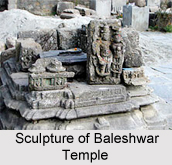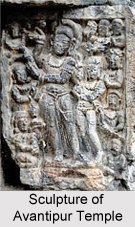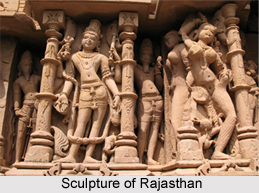 Sculpture of Northern India is enlisted among the most exquisite and graceful forms of art. The plethora of structures carved out of stones, metals, ceramics, wood etc exhibit a unique appeal. The art of sculpturing has emerged since pre historic times and several testaments of fine sculptures have emerged through various archaeological excavations. Temples and caves in different regions of Northern India stand as exemplary of this art work. A variety of structures is found among the Sculpture of Northern India which holds immense historical significance.
Sculpture of Northern India is enlisted among the most exquisite and graceful forms of art. The plethora of structures carved out of stones, metals, ceramics, wood etc exhibit a unique appeal. The art of sculpturing has emerged since pre historic times and several testaments of fine sculptures have emerged through various archaeological excavations. Temples and caves in different regions of Northern India stand as exemplary of this art work. A variety of structures is found among the Sculpture of Northern India which holds immense historical significance.
Sculpture of Haryana
Sculpture is an ancient form of art and has been prevalent in the state of Haryana since ages. Several Hindu temples are situated in this state that exhibits beautiful testaments of sculpture art. Various religious faiths have found powerful expressions through the sculptures of these temples. Sculptures of this state dates back to Indus Valley Civilisation. The most renowned temple sculpture of this state is Mansa Devi Temple located at Panchkula. Several other temples, dedicated to female deities, also stand which are finely carved out of a single stone. The most prominent examples of stone sculpture in these temples are pillars, inner sanctums and the towers of the temples. Sculptures of Sthaneshwar Mahadev Temple situated in Kurukshetra are also highly famed that attracts a number of tourists from all over the country.
 Sculpture of Uttar Pradesh
Sculpture of Uttar Pradesh
Uttar Pradesh is known for its spectacular clay and terracotta sculptures. The tradition of this art can be traced back to ancient times. The earthen look of these sculptures makes them highly fascinating pieces of arts. A number of artefacts are produced using the art of sculpturing which includes terracotta horses, idols of deities, showpieces and figurines. One of the important centres in Uttar Pradesh where a variety of items are produced is Gorakhpur.
Sculpture of Uttarakhand
Sculpture is enlisted among the prominent art works of Uttarakhand too. Numerous examples of fine sculpturing can be witnessed in various temples of this state. The black stone idol of Lord Badrinarayan in the Badrinath Temple is one of the most famous sculptures of Uttrakhand. Several other idols are also there in the temple which holds immense religious significance. Baleshwar temple also exhibit marvellous stone carving having south Indian style of architecture. An ancient example of this art can be found in Mahasu Devta Temple that was built in 9th century. Stone sculpture at its best can be seen in this temple. A number of admirable stone and bronze images are placed in the temple. Enchanting sculptures of Asuras and Devas portraying the Samudra Manthan can be seen in Neelkanth Mahadev Temple.
Sculpture of Jammu and Kashmir
Remarkable specimens of sculpturing are also found in Jammu and Kashmir. Various temples and caves are adorned with magnificent sculptures. Avantipur temple is an ancient temple that dates back to 855-833 A.D. Ruins of exquisite stone carving can still be witnessed in this temple. Kashmiri artwork has rendered graceful structures to the temples. Various sculptures in the temples of Jammu and Kashmir include depictions of royal families, figures of Kama Deva, King Avanthivarman, figurine of a dancing girl etc. Rich carving beautifully embellish the walls and pillars of this temple. Another ancient temple showcasing magnificent sculptures is Shankaracharya temple, built in 200 BC. Saspol Caves of Jammu and Kashmir houses a number of rock cut temples of 13th to 15th century. These are Buddhist temples having spectacular sculptures belonging to the Tibetan culture of medieval era. A fine blend of Tibetian and Indian Buddhist art are the most striking features of these sculptures.
Sculpture of Rajasthan
Sculptures of Rajasthan have overwhelmed mankind since time immemorial. This art mostly developed in medieval era to adorn the temples, forts, palaces etc. Jaipur, in Rajasthan, is considered as the centre of marble sculptures and a number of Jain temples exhibits testaments of this art. Stone and wooden sculptures of this state are also quite famous. Palaces and forts of Delhi, Agra and Fatehpur Sikri are made of red sandstone. Stone palaces and monuments of Bundi, Chittorgarh, Jaipur, Bikaner, Jodhpur, Udaipur and Jaisalmer are other examples of stone sculpturing in Rajasthan. The most prominent stone sculpture of Rajasthan is showcased by the Dilwara Temple in Mount Abu. Depiction of Ramayana through stone carvings is found in the Sas Bahu Temple. Rajasthan houses numerous examples of intricate and splendid sculpturing which embellish the ancient monuments, caves and temples of the state in most unique manner.
Palaces and forts of Delhi, Agra and Fatehpur Sikri are made of red sandstone. Stone palaces and monuments of Bundi, Chittorgarh, Jaipur, Bikaner, Jodhpur, Udaipur and Jaisalmer are other examples of stone sculpturing in Rajasthan. The most prominent stone sculpture of Rajasthan is showcased by the Dilwara Temple in Mount Abu. Depiction of Ramayana through stone carvings is found in the Sas Bahu Temple. Rajasthan houses numerous examples of intricate and splendid sculpturing which embellish the ancient monuments, caves and temples of the state in most unique manner.
Sculpture of Northern India has been an inseparable part of the religious and cultural history of the country. Different cultures of India have adopted this art for the depiction of a number of subjects. This splendid form of art not only allures the people of the country but also attracts tourists from different parts of the globe.



















